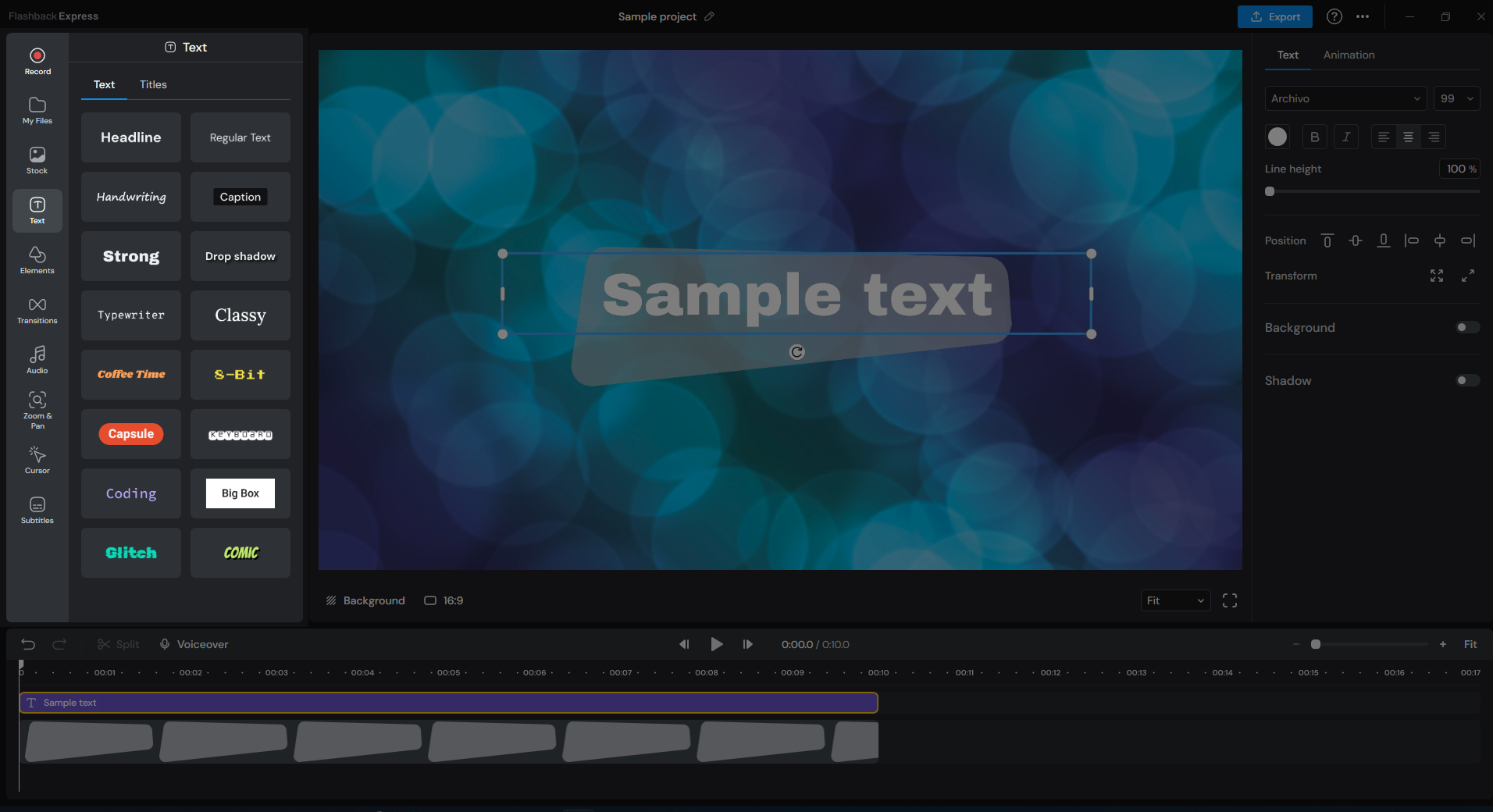Flashback Express 7
User Manual
Downloading and Installing
Recording a Video
Recorder Window
Recorder Settings
Selecting What To Record
Recording the Mouse Cursor
Starting and Stopping Recording
Recorder Control Bar
Advanced Recording Options
Annotating While Recording
Recording on a computer with dual GPUs
Previewing a Recording
Editing a Project
Editing Basics
Navigating the Project Editor
Working with Media
The Timeline
The Video Canvas
Styling Media
Editing Preferences
Exploring Media
Videos
Images
Animations
Shapes
Backgrounds
Text
Titles
Audio
Voiceovers
Subtitles
Blurs
Flashback Pro Movies
Applying Effects
Exporting
Licensing Flashback Express 7
Free vs Licensed Use
Purchasing a Flashback Express 7 License
Registering a Flashback Express 7 license
Upgrading From Pro 5 or Express 6
Managing Your Subscriptions
Feature Credits
Registering on an offline PC
Deploying a license to multiple PCs
License Troubleshooting
Misc.
How To Guides
Make a clip from a recording
Replace a voiceover
Record a facecam video
Schedule a recording session
Highlight the mouse cursor
Edit audio for an imported video
How To Move a Project to a New Computer
Record a clear voiceover
Flashback Express 7 Quick Start Guide
Flashback Express 7 FAQs
Flashback Express 6
User Manual
Downloading and Installing
Getting Setup to Record
The Recorder Window
Recording the Screen
Recording Windows and Regions
Recording Sound
Recording a Webcam
Recording the mouse cursor
Recording Settings
Recording
The Recorder Control Bar
Starting, Pausing and Stopping a Recording
Discarding or Restarting a Recording
Saving your recording
Scheduling a recording
Auto-trimming
Editing and Uploading
The Video Window
The Edit & Upload Window
Making a Clip
Uploading a Video
Exporting to other formats
Exporting Audio
Adding Subtitles
Licensing
Flashback Express Free vs Licenced
Purchasing a Flashback Express 6 license
Registering a Flashback Express 6 license
Registering Flashback Express 6 on an offline PC
Deploying a Flashback Express 6 license to multiple PCs
Flashback Express License 6 Troubleshooting
Feature Credits for Transcrptions
Misc.
How To Guides
How to record a facecam video
How to make a clip
How to schedule a recording session
How to capture the mouse cursor
Flashback Express 6 Quick Start Guide
Flashback Express 6 FAQs
Camigo
User Manual
Getting Started
Camigo System Requirements
Downloading and installing
Setting up Camigo
Checking for Updates
Camigo Settings
Using Camigo
Customizing your video
Licensing
Support
Camigo Quick Start Guide
Camigo FAQs
Video Converter
User Manual
Getting Setup
Video Converter System Requirements
Downloading and installing Video Converter
Preferences
Free Trial
Using Video Converter
Converting Format
Format settings
Turbo Conversion
Creating Clips
Cropping a video
Applying Effects
Adding Watermarks
Changing Speed
Inserting Subtitles
Licensing Video Converter
Video Converter Quick Start Guide
Video Converter FAQs
Table of Contents
- All Categories
- Flashback Express 7
- User Manual
- Editing a Project
- Editing Basics
- Working with Media
Working with Media
Updated
by Gareth Casey
The Media Panel is located down the left side of th Project Editor and is where you will find all of the media that can be added to your project.

Finding Media
Using the tabs down the left side of the Media panel, you can access libraries of stock videos, images and audio or import your own, as well as find a selection of shapes and pre-made template elements. Videos and images can be found in the Stock tab and music can be found in the Audio tab.
Any videos, images and audio that you import or videos that you record using the Recorder will be added to the My Files tab.
See Exploring Media to learn more about the different types of media that can be found in the Media Panel.
Adding Media
When you have found something that you want to add, you can add it to your project by simply dragging and dropping it on to either the Video Canvas or Timeline to add a media object.
To the Video Canvas
If the media is dropped on to the Video Canvas, the object will appear in the exact spot on the canvas where it was dropped and an object will appear on the Timeline beginning at the current frame. The new object will appear on top of all existing objects and a new track will be created onthe TImeline to hold it, if there isn't one already.
To the Timeline
If the media is dropped on to the Timeline, the object will begin at whatever time it was dropped on and the object that appears on the canvas will be added at the default position in the center of the canvas.
If there are objects already on the Timeline, you can make the new object appear on top of the existing object by dropping it into a track above the existing object or behind it by dropping into a track below it. If tracks don't already exist above or below the existing object, a new one will be created to hold the new object.
Customizing Media
The first thing that you will probably want to do to any media that you add is set the size and position of it on the Video Canvas and set the start time and duration on the Timeline
On the Video Canvas
Any object can be moved by simply clicking and dragging it to a new position on the canvas and it can also be resized by clicking and dragging the corners of the object.
When resizing by dragging the corner, the proportions of the object will be locked so it will always increase in height and width together.
For Videos and Images, clicking and dragging on the edges of the object will allow you to crop the image down. For all other types of media, dragging the edge will simply change the size of the object in that single direction rather than changing the height and width together.
Objects can also be moved forwards and backwards relative to other objects by right clicking on the object and selecting from Bring Forward, Bring to Front, Send Backwards and Send to Back.
On the Timeline
The time when an object is displayed can be adjusted by dragging the object forwards or backwards along the time line
The duration of an object can then be adjusted by hovering the mouse cursor over either end of the timeline object and clicking and dragging to extend of shorten it.
Alternatively, the Split option can be used to split a single object into 2 smaller objects. The split will be made at the current frame.
In the Style Panel
When an object is selected on either the Canvas or the Timeline, it's style properties will appear in the Style Panel. The specific style options vary depending on the type of media but will include things like Opacity, Color and Fades.
